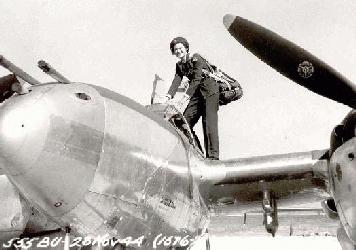

| This text copied from HERE
Love proposed that 21- to 35-year-old women possessing a high school diploma, US citizenship, a commercial pilot's license, 500 hours of flying time, and a 200-horsepower rating be hired as military ferry pilots. They would ferry primary trainers and liaison aircraft for a $250 monthly salary plus a $6 per diem for any time spent away from their assigned base. Maj Gen Henry H. "Hap" Arnold, chief of the Air Corps, initially rejected Love's proposal but, in September 1942, facing a growing need for male combat pilots, approved formation of the WAFS. The squadron was organized at New Castle Army Air Base, Wilmington, Delaware, as a separate organization under Love. It consisted of 25 pilots, known as the "Originals," who averaged 1,100 hours and were among the most experienced young pilots, male or female, in the country. Meanwhile, as early as 1939, Jackie Cochran had suggested recruiting and training women to fly military aircraft. On 7 October 1942, shortly after the WAFS was formed, General Arnold inaugurated a flight-training program to produce 500 women ferry pilots. He appointed Cochran as the director of flying training, and by October 1942, 40 women had been accepted and sent for training at Howard Hughes Airport in Houston, Texas. The unit was called the WFTD, or among the women it was known as the "Woofteddies." When facilities at Houston proved too limited, a new school was opened in February 1943 at Avenger Field, Sweetwater, Texas, and training at Houston soon phased out. On 5 August 1943, the WAFS and the women of Cochran's WFTD school were united as the WASP. Cochran was named Director of Women Pilots, and Love continued in the WASP as executive of the Ferrying Division of the Air Transport Command. Classes entered the WASP program at monthly intervals. A total of 18 classes completed training: 8 in 1943 and 10 in 1944. Of the 25,000 women who applied for flight training, 1,830 were accepted, and of those, 1,074 received their wings. Entrance requirements remained essentially the same as those for the WAFS, except the age requirement was dropped from 21 to 18, and the flight experience was set at only 200 hours. That requirement was later dropped to 35 hours, and the 200-horsepower rating requirement was eventually eliminated. Training for women pilots paralleled but did not duplicate that given the men. Because the women were expected to go into ferrying, emphasis was placed on cross-country flying. Gunnery and formation flight training were omitted. The first course was four months long. Although the hours were flexible and varied according to previous training, 115 flying hours were generally called for in addition to 180 hours of ground instruction. As the experience level of the trainees declined, the course was expanded and revised. By the close of 1943, the length had been extended to 27 weeks and the flying hours to 210. Few curricular changes were made in 1944; the main one increased training from 27 to 30 weeks. During the early stages of the program, an 80 percent graduation rate had been anticipated for the women trainees. The actual rate averaged out at 74 percent for the 1943 graduates and 53 percent for the 1944 classes, the latter considerably better than the attrition rate for male trainees in the Central Flying Training Command in 1944. The increase in washout rates probably reflected the lower flight experience among the later classes. The WASPs flew all types of military aircraft, including AT-6, AT-10, AT-11, and BT-13 trainers; C-47, C-54, and C-60 transports; A-25 and A-26 attack aircraft; B-24, B-25, TB-26, and B-29 bombers; P-38, P-40, P-47, and P-51 fighters. In addition to ferrying, the WASPs performed many other tasks such as glider and target towing, radar calibration flights, aircraft testing, and other non-combat duties to release male pilots for overseas action. The WASPs flew approximately 60 million miles and suffered 38 fatalities, or 1 to about 16,000 hours of flying. The WASPs were employed under the Civil Service program. It was always assumed they would become part of the Army when a proper place within the military organization could be found for them. In fact, bills were introduced in Congress to give them military rank, but even with General Arnold's support all efforts failed to absorb the WASPs into the military. On 20 December 1944, the AAF, citing the changing combat situation, disbanded the WASP program. The WASPs returned to civilian life with no veterans' benefits. In 1978 Congress finally granted benefits to the 850 remaining WASPs. |